Rules of chess
In order to start to play chess, it is necessary to know the rules. At the first glance, they may look quite simple, but in fact you have to spend quite a lot of time to learn how to play chess.
The chessmen are located on the board which is divided equally into 64 black and white squares. The initial position of the figures is as follows:
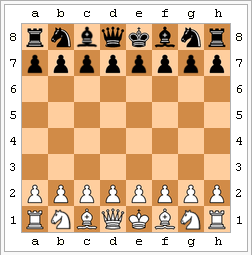
The board is marked across with the Latin letters from A to H, and down with the digits from 1 to 8. These letter and digits are used for reference when recording the game. Prior to the commencement of the game "blacks" and "whites" have the equally number of pieces positioned symmetrically, as shown on the picture.
The following figures set constitute the chess set (black and white).
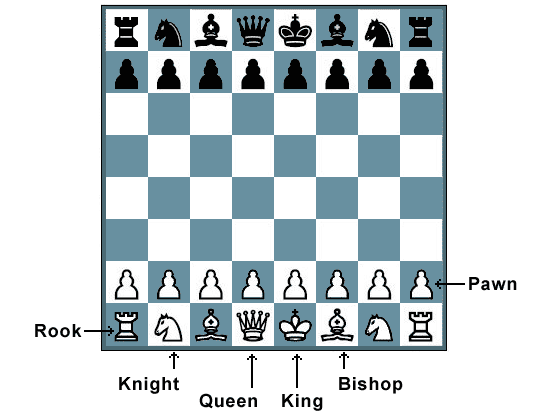
Let us look at how the each of the figures moves.
The King is the main chessman in the game but at the same time it is the most attackable. If it is mated (i.e., has no possibility to move and is in check), the game is over.
The possible King's moves are marked with x on the picture. The King may move to any of the neighbor squares down, across or even diagonally. The King cannot move to a square occupied by any of the figures belonging to the King's team or to the any filed being attacked by the opponent's figures (i.e. where the King may be in check).
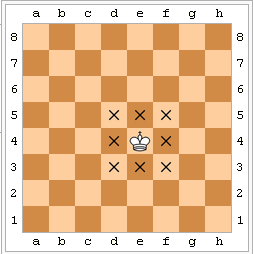
The King's peculiarity is that it may do the castling. The castling is a King's move done together with the Castle. The King moves two squares in the Castle's direction, and the Castle, in turn, moves towards the King and takes the neighbor square already passed by the King. There are two types of the castling - short one and long one. The short castling is made on the King's flank and the long one on the Queen's flank.
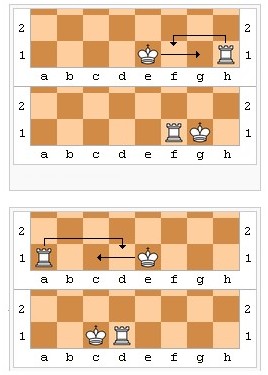
The castling cannot be made:
-If the King has already made a move
-If the Castle intended to be involved has already made a move
-If the neighbor squares are occupied (G and F for the short castling and B, C, D for the long one)
-If after the castling the King will end up being in check
-If the King is in check (and tried to get out doing castling)
-If in the course of the castling the King is supposed to pass the square being attacked by the opponent's figures.
In the game record the short castling is referred to as 0-0 while the long one is 0-0-0.
Check is the situation where the King is being attacked by the opponent's figure. In such a situation you can:
-defend yourself against check
-beat the attacking figure by one of your figures
-move the King to the any of the squares not attacked by the opponent's figures.
Mat is the position where the King is in check but he has place to move (as all the free squares are being attacked by the opponent's figures), no chance to beat the attacking figure and no option to defend against check.
Stalemate is such a position where the King has nowhere to move (as all the free squares are being attacked by the opponent's figures), but the King is not in check and the player has no other figures to play with or there is no possibility to move any of the other figures.
Queen is the most powerful figure of the game. It's constructed value is 8 pawns. The Queen may move across, down and diagonally taking any free square if there are no occupied squares on it's way, combining the force of the Bishop (moving diagonally) and of the Castle (moving across and down).
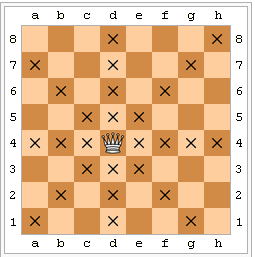
Rook. It's constructed value is 5 pawns. It may move across and down to the any square if no occupied fields on the way.
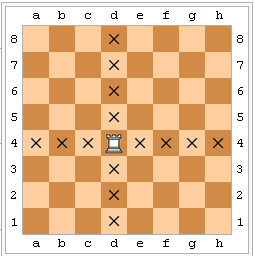
Bishop. It's constructed value price is 3 pawns. It may move diagonally to any square if no figures on the way. There may be black-square and white-square bishops, moving on the black and white squares, correspondingly.
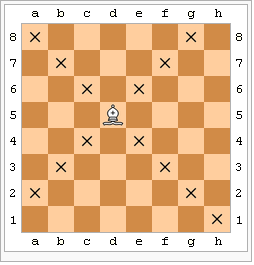
Knight. It's constructed value is 3 pawns. It moves by L-trajectory, i.e. it starts with moving two squares forward vertically and then one to the side across; alternatively, it may move one square vertically and then two across which also forms "L" letter. The Knight's peculiarity is that it may "jump" over other figures.
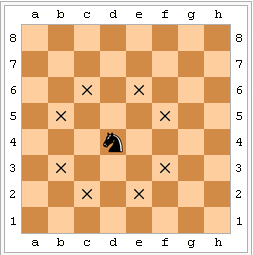
Pawn. Moves down but beats diagonally taking the place of the beaten figure. If the pawn is in the initial position (e.g. on E2 square) it may jump over one square (on E4) or move only one square ahead (E3). If the pawn is not in the initial position it may only move one square ahead.
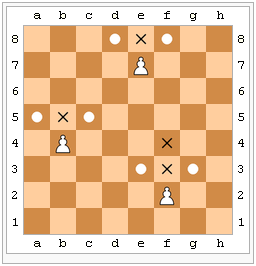
We need to clarify the "beaten square" definition. It is the position where, for example, white pawn has reached E5 while the black one is still in it's initial position. The black pawn makes the D7-D5 move and in such case the white pawn may beat the black one moving on D6 square.
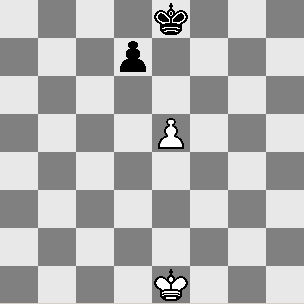
One more peculiarity of the pawn is that, having reached the no. 8 horizontal line (for the white) and no. 1 horizontal line (for the black) it may turn into the any figure.
The whites start the game, and then the blacks make a move and so forth. Only one figure may be moved at a time. The game is over when one of the parties is mated or when both opponents agree on the draw. Additionally, the game may be over when one of the opponents has spent all the time he was given for the game.
With the each victory the winner gets one point, the loser gets zero points. If there is a draw, both opponents get 0.5 points.
A couple of words more. The rules of the game changed from time to time. At the moment, the rules are fixed, and most probably will not change. They may get changed only in the case if the human makes such a computer which will count all the moves from the beginning of the chess game to it's end. We would think that is impossible at the moment. Already, there are 100-square chess invented. In the latter case there is one more figure added, called the Rocket.
Should there be anything unclear to you with regard to the rules (of the regular chess), you may ask your questions on the comments to this article.